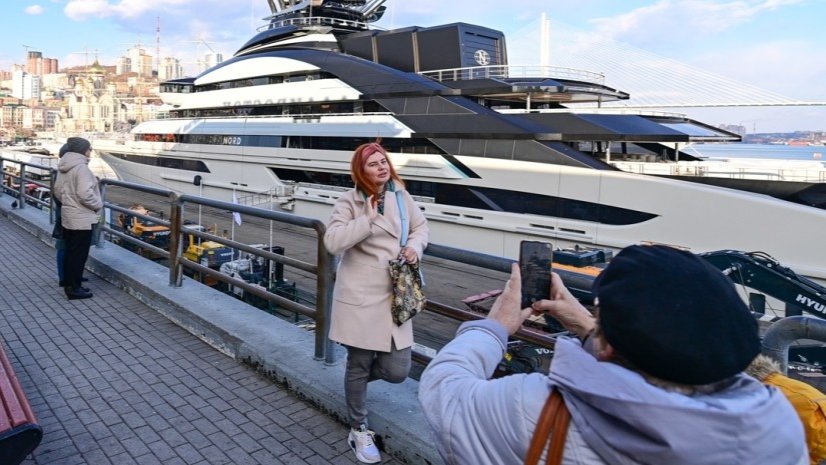A large portion of Russia’s establishment was sanctioned by the EU, the UK and/or the US. The West has declared a hunt for the assets of Russian oligarchs, including their yachts. A total of 16 yachts linked with people who are believed to be close to the Kremlin have been seized since 24 February. We have analysed almost 5 million km worth of travels made by 27 yachts de-facto owned by Russian oligarchs over the past 14 years. We found out how they tried to avoid the Ukraine War sanctions, where they loved to spend time before the war began and where do the “blind spots” in their routes come from.
Yacht Racing Deathmatch
The Ukraine War took the crews of Russian superyachts by surprise. In February, the boats were roaming the Mediterranean waters at a leisurely pace or undergoing repair in Marseille or Hamburg. Some oligarchs were having a lovely winter voyage in the Indian Ocean — or in the West Indies. They would even ignore the ongoing events and carry on their usual movement in the first couple of days after the invasion began, as if they received lagged battlefield reports. It was only on 26 February that the yachts started to flee for safe havens one by one.
Nord, a 142 m superyacht owned by Alexey Mordashov, the chairman of Severstal, a steel and mining giant, was skirting the Seychelles in the Indian Ocean on 24 February, according to MarineTraffic. It had been roaming the blue lagoons of the subtropics in the warm equatorial winter weather for two months by that time. A huge boat with six decks equipped with two helicopter landing pads, a swimming pool, a diving facility and even a small submarine, it was launched in Germany in July 2020 and is evaluated at 300 to 500 $ million.
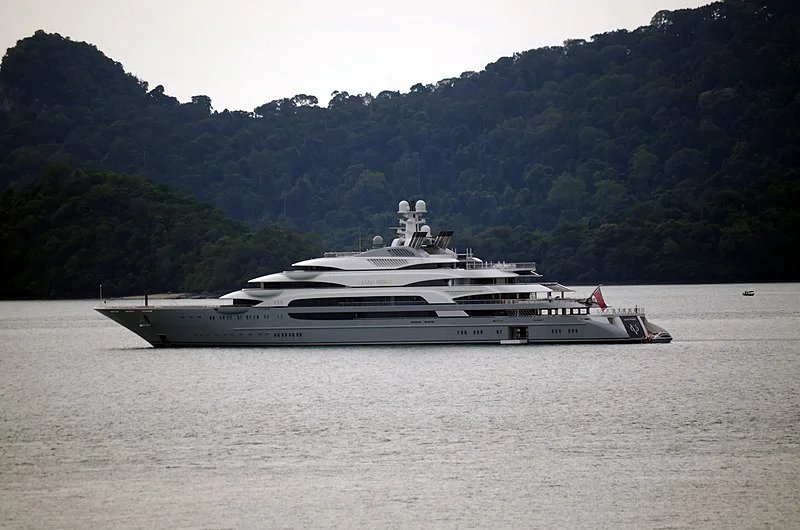
Ocean Victory. Photo: Wikipedia
Nord was not alone in the Indian Ocean in February 2022. Ocean Victory, a 140 m yacht of Viktor Rashnikov, owner of the Magnitogorsk Iron and Steel Works, and the 140 m Clio, owned by oligarch Oleg Deripaska, were nearby in the Kaafu Atoll of the Maldives. The atoll also had some smaller Russian yachts at that time, such as Vladimir Potainin’s 88 m Nirvana and the 66 m Titan yacht owned by Alexander Abramov of the Evraz Group.
The United States, as well as the United Kingdom and the European Union, imposed their third package of sanctions on 28 February, putting 160 Russian businesspeople and MPs on the list. The yachts of Russian oligarchs have started leaving the Seychelles and the Maldives in a hurry since 1 March to avoid potential seizure.
You may point your mouse on the anchor icon on the map for details.
Deripaska’s Clio headed for the Red Sea and reached the shores of Turkey via the Suez Canal. The crew switched off the ship’s transponder in the port of Lapseki near Istanbul on 18 April. The yacht was spotted in Sochi later in early May.
Nirvana, owned by Vladimir Potanin who was sanctioned by Canada, left the Maldives on 2 March, and headed for Dubai where it dropped its anchor on 8 March and has remained there ever since.
Abramov’s Titan left the Maldives for Dubai on 12 March as well. The ship set off for Turkey’s Bodrum on 25 April. It is now cruising along the Aegean shore of Turkey.
Nord departed from the Seychelles on 13 March and arrived in Russia’s Vladivostok on 31 March. It covered a distance of 10,300 km in just 18 days as it sailed through Malaysia, the South China Sea, went round Taiwan, then crossed the East China Sea and the Sea of Japan before reaching the Russian Far East. A crowd of photographers welcomed the superyacht in Vladivostok’s Golden Horn Bay. The luxurious ship quickly became a local attraction with people coming from other cities to take photos with it.
A few other billionaires also managed to save their yachts from seizure. Two ships owned by Roman Abramovich, Eclipse and Solaris, are now in the Turkish ports of Marmaris and Bodrum, respectively. Eclipse was forced to cross the Atlantic to reach the safe haven in Turkey. It departed from the Dutch island of Sint Maarten in the Caribbean on 4 March. Abramovich was seen in Turkey in person where he took part in the last session of face-to-face negotiations between Russia and Ukraine.
Galactica Super Nova, a 73 m yacht linked with Vagit Alekperov, the founder of Lukoil, was docked in Barcelona as of 24 February. It was planning to find shelter in Montenegro as the crew switched off the transponder on 2 March as the ship was approaching the port of Tivat. It is unknown where the ship is at the moment.
We did not manage to track the rest of the sanctioned yachts where transponders were switched off before setting sail. Rashnikov’s Ocean Victory disabled its transponder on 1 March near Malé, the Maldivian capital.
Alfa Nero, linked with Andrey Guryev, the former head of FosAgro, last transmitted its data on 1 March near Puerto Rico. Sky, linked with Igor Kesaev who owns Russia’s biggest tobacco distributor, stopped transmitting its location on 1 April near Panama.
However, many Russian yacht owners failed to avoid the sanctions and had their ships seized. Axioma, allegedly owned by Dmitry Pumpyansky of TMK, was one of such yachts.
When the invasion began, Axioma was leisurely cruising near Saint Barthélemy and Antigua & Barbuda in the Caribbean. The boat set sail on 7 March and headed for the Mediterranean. As it travelled across the Atlantic, Pumpyansky was sanctioned by both the EU and the UK. As a result, the yacht was seized by Gibraltar, a British Overseas Territory, on 21 March.
Amadea, a 106 m superyacht linked with Suleyman Kerimov, the former owner of Anzhi Makhachkala FC and currently a member of the Federation Council, Russia’s upper house of parliament, was also located in the Caribbean on 24 February, but opted for a different escape route. It started off the shore of Antigua and Barbuda and headed east. The yacht made it through the Panama Canal on 18 March, made a stop in Mexico and headed for Australia.
The ship reached Fiji in April and was ready to set sail for Vladivostok. This, however, never happened as the ship was seized upon the request of the United States on 14 April. The local court decided to hand the ship over to the US on 7 June as the ship’s maintenance drained too much money from the state budget. Amadea’s annual maintenance fee is believed to be between $25 and $30 million, according to the FBI.
The EU, US and UK seized a total of 16 superyachts linked with Russian billionaires. The estimated overall cost of the seized vessels is believed to be around $4 billion. 11 ships were seized in the ports of Spain, Italy and France. Two more yachts were seized in Germany where they underwent scheduled repair. The United Kingdom, Gibraltar and Fiji seized one vessel each. They will remain officially detained until their real owners are found.
All the President’s Yachts
It is believed that Vladimir Putin may de-facto own a total of six yachts. At least one of them, an 82 m vessel named Graceful managed to avoid seizure after the war had started. The ship was constructed by Russia’s Sevmash in 2014. The pictures of Graceful were posted by The Market Herald in April. The Australian media outlet found out the ship had its own aquadisco, a dancefloor transformed into a swimming pool. The ship’s amenities also include a wine cellar, six guest cabins, a private office and a library.
Graceful was in Hamburg’s shipbuilders Blohm & Voss on 7 February where it was being upgraded. The works were scheduled to finish in May 2022, according to BBC. The ship, however, set off for Russia’s exclave of Kaliningrad two weeks before the war started. It is unknown where the yacht is at the moment, its transponder is switched off.
Scheherazade, the most luxurious superyacht of Putin’s alleged fleet, was seized in Italy in May. Its value is believed to be over $700 million.
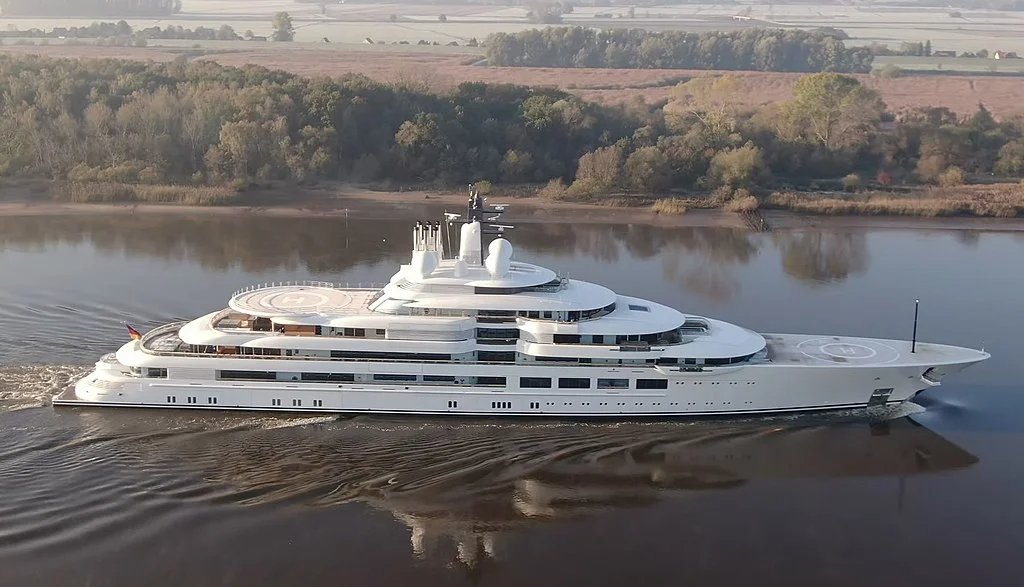
Scheherazade. Photo: Wikipedia
The earliest data on Scheherazade’s travels is of June 2020 when it sailed from the German port of Blumenthal to Norway’s Kristiansand. It travelled from Gibraltar to Croatia’s Dubrovnik between 3 and 12 June 2020. The yacht has been mostly sailing between Croatia and Montenegro ever since, sometimes visiting Turkey’s Bodrum and Istanbul, Egypt’s Hurghada, Cyprus and even Sochi. Scheherazade used to undergo technical maintenance in Italy’s port of Marina di Carrara every year; this is where it had been docked since last September and then seized by the Italian authorities in early May.

Graceful. Photo: yachtoteka.ru
Putin’s alleged yachts often travel alongside other vessels. Graceful often cuts the sea together with Alekperov’s Galactica Super Nova. Both yachts were spotted at the same time in Barcelona in 2017 and in Tivat, Montenegro, in 2021. On separate occasions, Graceful was also seen in Barcelona together with Alisher Usmanov’s Dilbar, Pumpyansky’s Axioma and yachts linked with Andrey Guryev, Abramov and Rostec’s chairman Sergey Chemezov.
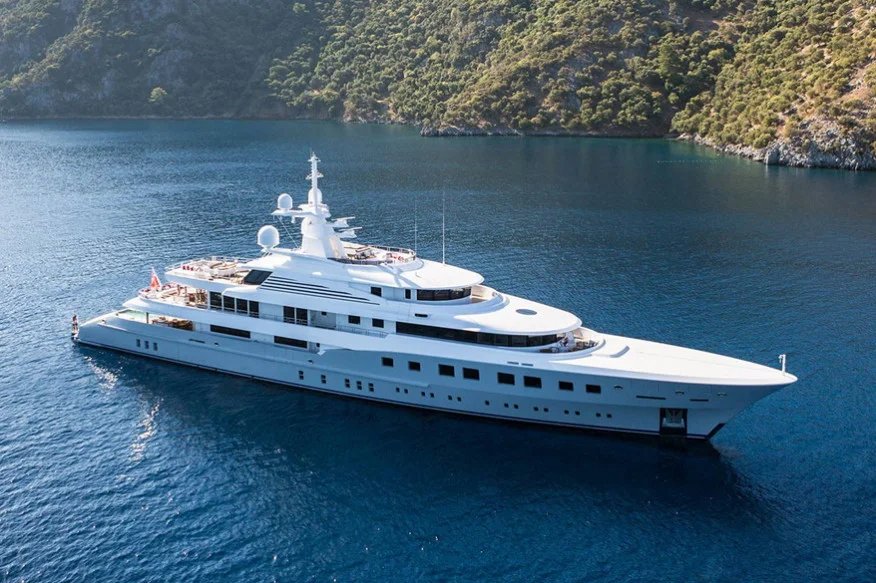
Axioma. Photo: yachtoteka.ru
Scheherazade shared the same dock with Pumpyansky’s Axioma, Viktor Vekselberg’s Tango and Alekperov’s Galactica Super Nova in Dubrovnik in June 2020. Next month, Scheherazade was seen in Tivat together with the yachts of Vekselberg, Alekperov and Oleg Deripaska.
The ship also “met” the yachts of Abramovich and Pumpyansky in May 2021 in Croatia. Finally, it was docked in Tivat together with Alekperov’s Galactica Super Nova in June and September 2021.
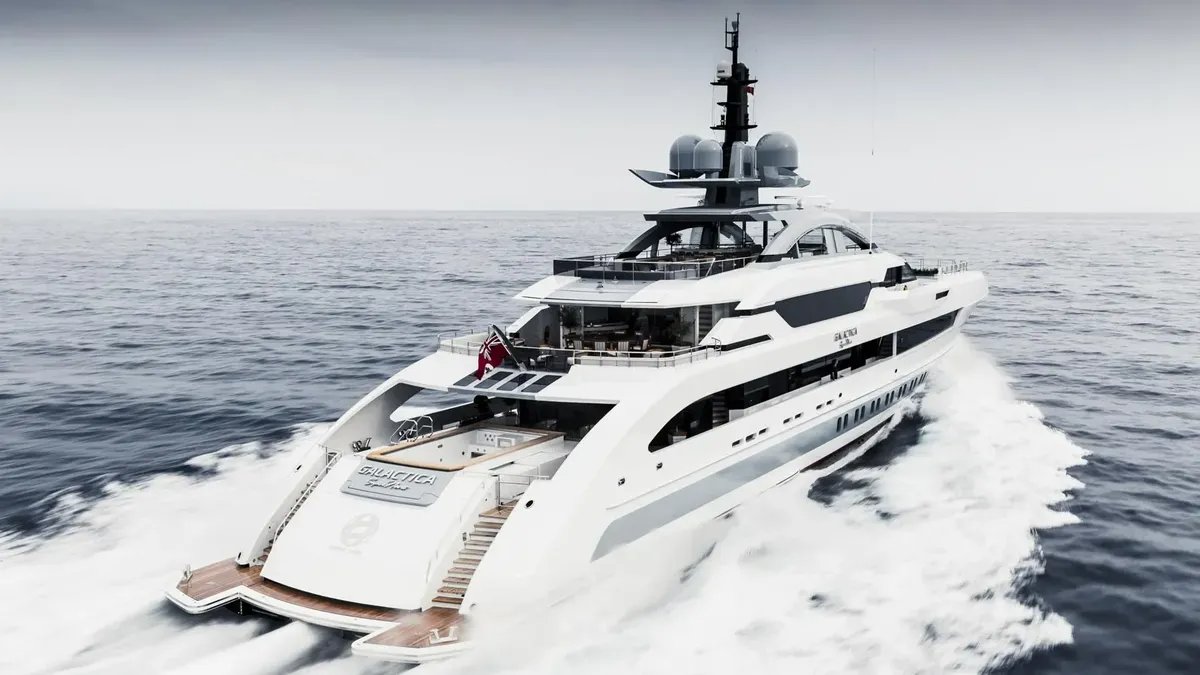
Galactica Super Nova. Photo: heesenyachts.com
The Forbidden Waters
If you own a superyacht, you can travel to any place in the world: you may go round the Tierra del Fuego, reach the Antarctic, visit Greenland, Madagascar or the Kamchatka Peninsula. However, the luxurious vessels rarely if ever sail to such locations. Their favourite destinations are the West Indies, the Mediterranean, and the subtropics of the Indian Ocean easily reached via the Suez Canal. They often go in “schools” just like fish.
The Mediterranean Sea is the top priority for all the oligarchs. France, Italy and Spain have the best infrastructure for yachting, including the world’s best marinas, says Maria Moshkina of the Russian Yachts magazine. These countries have a jagged coastline and many isles; Europe’s noble high life is concentrated ashore.
The other options are Greece, Montenegro and Croatia. These countries offer cheaper maintenance and a rapidly developing yachting infrastructure.
Palma de Mallorca is the top destination for the Russian oligarchs. Located in the heart of the Balearic Sea, this port city is the capital of Spain’s autonomous community of the Balearic Islands. Lady Anastasia, linked with Aleksandr Mikheyev, director of Rosoboronexport, is a most frequent visitor of Palma. This is the yacht a Ukrainian citizen tried to sink recently.
A total of 27 superyachts owned by Russian oligarchs and officials entered Palma’s port on at least 329 occasions between 2008 and 2022. They spent at least 1928 days there in total. The nearby island of Ibiza turned out to be slightly less popular among the Russian oligarchs: only 106 visits and a total of 100 days on the record.
The French Riviera follows the two Spanish resorts in terms of popularity. The city of Antibes, located between Cannes and Nice, is of special importance. It is not overcrowded with tourists and has restricted recreation zones. The city’s coastline is filled with luxurious vacation homes.
This is where Cap-Eden-Roc, a high-end hotel featured in Tender Is the Night, a novel by F. Scott Fitzgerald, is located. Ernest Hemingway, Marc Chagall and Marlene Dietrich all stayed in the hotel at some point. The Antibes marine was visited by the Russian superyachts a total of 229 times and; they spent at least 1618 days there altogether.
The European infrastructure is not only about the best hotels and parties, but also the top-tier yachting docks. The French commune of La Ciotat near Marseille has the third most popular marina in our ranking. It also has Europe’s biggest port for repairing and maintaining the most luxurious superyachts. The Russian vessels have visited La Ciotat 216 times over the past 14 years, spending a total of 3645 days.
Superyachts are as complex as aircraft in terms of their configuration. They usually have lots of equipment installed: engines, pumps, water distillers, air conditioners, fire-fighting systems and navigational gadgetry. All this requires regular maintenance. Besides that, the ships often face aggressive environments when they travel across the subtropics.
Intensive UV radiation and hypersaline water erode the ship’s body. Therefore, a yacht needs to be docked once in a while to have its bottom cleaned and its upperworks polished. The superyachts of the Russian oligarchs were all maintained in Europe.
The most prestigious dockyards are located in Germany and the Netherlands. This is where the superyachts for Russian oligarchs are constructed, launched, maintained and upgraded. Other places capable of repairing yachts are Barcelona, La Ciotat, La Spezia, Genoa and other coastal cities in Spain, France and Italy. This is why the yachts in question spent so much time in those locations.
Le Lavandou is another popular commune near Marseille. This place took the fancy of Gennady Timchenko and his yacht Lena, named after his wife who owns 55% of shares at the luxurious Le Club de Cavalière hotel in Le Lavandou. This property was seized by the French authorities in April, just like Hôtel Le Grand Cœur & Spa in Méribel, also owned by Elena Timchenko.
Monaco is another beloved country for the Russian billionaires. All yachts on our list, excluding those of Vladimir Putin and Igor Sechin, visited the principality’s port, adding 192 visits and 576 days to the record.
The importance of the Mediterranean for the Russian oligarchs cannot be overestimated. The yachts spend at least 71% of their time in the European waters, including those of Sweden and the UK. Given that their time in the neutral waters, as well as the time spent with a switched off transponder does not make it count, this number might be way higher. These areas became unavailable to the Russian yachts after the sanctions were imposed. They are marked in red on our map to the right.
It is, however, impossible to get the full picture of the oligarchs’ voyages. The International Convention for the Safety of Life at Sea only allows captains to switch off the ship’s transponders in exceptional cases when navigational information may harm the ship.
However, the yachts of the Russian officials and oligarchs often neglect this and switch off their transponders to conceal their location. This is where the “blind spots” come from. They do not only appear in Europe; such spots can be discovered between Russia’s Black Sea resorts of Sochi, Adler and Gelendzhik.
“There are no international sanctions for sailing with a switched off transponder; although certain ports may be against it. A yacht might be detained by the port’s officials to make sure it is safe for travel. It can also be searched,” says Konstantin Krasnokutsky, chairman of the Russian Maritime Law Association.
Spain tops the “blind spots” ranking. The Russian yachts switched off their transponders there for longer than two days on 226 occasions since 2008. Spain is followed by Italy (107 occasions) and France (76).
Russia’s oligarchs and officials may be switching off the transponders in order to conceal their real estate if they wish to keep their assets secret in order to avoid sanctions or for other reasons, experts believe.
Sometimes groups of vessels go off the grid simultaneously. There are huge blind spots near Croatia’s island of Mljet. Three yachts switched off their transponders in the same period in 2020: Abramovich’s Eclipse (28 June), Deripaska’s Lady Anastasia (1 August) and Pumpyansky’s Axioma (10, 17 and 18 July). The three most likely spent time together and wished to keep their meeting secret.
Yachts owned by Russian officials switched off their transponders most often. Out of six yachts who spent over 50% of their lifespan with transponders off, five are owned by the state officials or chairmen of the state-controlled companies. Another 21 ships had their transponders off less often; a total of 16% of time. Only three yachts never switched off their transponders. Those are Abramovich’s Solaris, Mordashov’s Nord and Viktor Kochetkov’s Phi.

My Solaris. Photo: boatinternational.com
Graceful и Scheherazade, linked with Vladimir Putin, spent most time off the grid, 77% and 82% of the time, respectively.
It is common practice for Graceful to remain undetected for longer than three months, most frequently near the shore of Spain. The yacht “teleported” from Turkey’s Zonguldak to Sochi in 2018. In 2019, Graceful disappeared from the map near Marseille and then reappeared near Barcelona. Additionally, the ship went off the grid for six months in 2020.
***
The EU sanctions were a painful blow upon the Russian oligarchs and their yachting activities. 26 out of the 27 sanctioned yacht owners will not be able to enter the territorial waters of the EU countries. Vladimir Potanin is the only exception since he has only been sanctioned by Canada as of now. A total of 16 yachts have already been seized.
Moreover, the lovely resorts of Florida, the Bahamas and – partly – the West Indies will be unavailable for the sanctioned billionaires. Saint Kitts and Nevis, as well as the British Overseas Territories of Anguilla and the Virgin Islands will not see any Russian yachts anymore. There is a lot of cooperation between the Caribbean nations and the United States, which makes travelling to these countries very risky for the sanctioned oligarchs.
“Turkey, Russia, Asia and the Pacific might become a good alternative for them. Thailand, Malaysia, the Seychelles, and the Maldives are all suitable countries for yachting, although it is far cry from Europe. This is somewhat more exotic,” Maria Moshkina says.
The Maldives government is not going to pressure sanctioned Russian oligarchs or seize their yachts, Reuters wrote in early April. Russia’s billionaires often visit this island nation in winter or early summer when it is too cold and snowy in Russia. The yachts of Russian oligarchs entered the port of Malé, the country’s capital, on 101 occasions.
Join us in rebuilding Novaya Gazeta Europe
The Russian government has banned independent media. We were forced to leave our country in order to keep doing our job, telling our readers about what is going on Russia, Ukraine and Europe.
We will continue fighting against warfare and dictatorship. We believe that freedom of speech is the most efficient antidote against tyranny. Support us financially to help us fight for peace and freedom.
By clicking the Support button, you agree to the processing of your personal data.
To cancel a regular donation, please write to [email protected]
